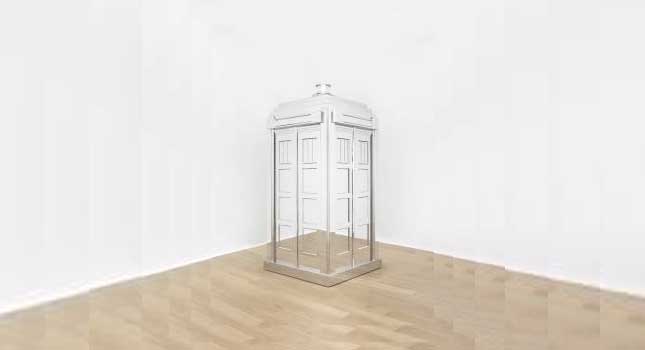
The eclectic mix of pieces on show gives much for viewers to look at. Spanning four rooms there’s no mistaking that this is an extensive body of work. Wallinger has certainly left no corner of the gallery untouched. The work has been curated in such a way that the audience is led in a twisting, turning path as they navigate past the many projected films, circulate round the sculptural pieces and zig-zag between the wall paintings. This is Wallinger’s first large-scale exhibition in Scotland and runs from 4th March until the 4th June.
Without a doubt the id Paintings are the main event. Impressive in size and striking in appearance, these paintings certainly leave their mark. Described as self-portraits these canvases were built from measurements of his own body. The width is that of his arm span and the height is double his own: in essence they are huge! References to the body don’t stop there. The symmetrical, and almost primal looking, imagery was created by the artist dragging paint across the surface with his own hands. These canvases are traces of the images’ evolution and the artist’s sweeping bodily motions.
While peering at these marks I could not help but think about the childhood craft of creating symmetrical patterns by painting on one side of the paper and folding it in half. This perhaps parallels the freedom experienced by the artist in creating his work in such a messy, raw way.
A recurring theme is the capturing of a moment of time. His id Paintings do this in the way they show the moment of making and many works continue this exploration. One memorable work “Ever Since” shows time unfolding in a ‘still’ image. Essentially it is a looped two second clip of the front of a barbers shop. Sounds boring? Although the idea is simple, it is actually pretty fascinating to watch. Everything in the shot remains still except for the red and white pole which spins seemingly continuously. You could be fooled to believe this is an unending video. The pole rotates and all the time you wait for passers-by to walk across the screen. Except they never do. Only the keenest eye will notice in the window of the shop a clock with the second hand twitching back and forth, revealing the trick. That it is in fact only a few seconds of footage.
As if Wallinger likes keeping his audience unwittingly trapped in fragments of time, he does it again, or should I say we fall for it again, in “Orrery”. This time the subject is a large tree in the middle of a roundabout that was recorded on his iPhone blue-tacked to a car window while he drove round in circles. The footage is shown on four screens facing each other. The viewer stands in the middle attempting to follow the tree round in the shots and getting quite dizzy. There is no start and end to the film so the car goes round and round for eternity.
In amongst all the other works stands one object that even the most culturally sheltered visitor would recognise. Rather than the familiar blue colour we are used to, this one is decked out in a shiny mirrored exterior. After getting over the initial disappointment of realisation that no the Doctor isn’t going to suddenly open the door, it soon becomes apparent that this Tardis, rather than increasing in size in the inside, in fact expands by reflecting its surroundings. By mirroring the gallery walls around it it starts to blend in and disappear, becoming a part of the space.
Despite the ‘moment in time’ associations, the Tardis piece (or “Time and Relative Dimensions in Space”) seems disjointed from the rest of the work. The cultural reference is too explicit and is disconnected from the more ordinary, everyday and messy nature of the other works on display.
Visitors aren’t short for things to see in the Mark Wallinger exhibition at the Dundee Contemporary Art centre, and there are many more pieces exhibited. Just keep an eye on your watch as this exhibition has a funny way of making you lose track of time.


